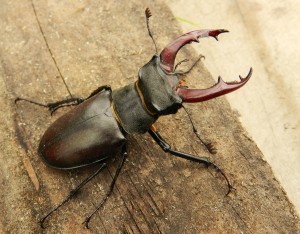The Stag Beetle (Lucanus cervus) is the largest beetle found in the UK and can be up to 75 mm long, with the ones I have observed in Reading being approximately 55mm, but still an impressive sight! (Figure 1)
Reading at present seems to have a healthy population of these beetles which play a crucial role in ecosystems by breaking down decaying wood both standing in dead trees, roots and stumps. The males especially are on the wing (yes these goliaths can fly), from late May–August from dusk onwards. They are often seen flying on warm humid nights and have names such as the Thunder Bug and Oak Ox. Most of my observations in Reading have mainly been from mid June to early July around street lights. Unfortunately, there is also the possibility that the flight season/emergence period of this species is becoming shorter as a result of the effects of climate change and declining populations due to lack of decaying material, which restricts early and late emergences. The larvae develop for up to 7 years and are white/cream in colouration, have a large orange head, brown jaws and curl into a distinctive C shape when disturbed (Figure 2). There is sexual dimorphism within the species, and only the males have the impressive antlers (mandibles) (Figures 3, 4 and 5), where the name originates from Red Deer (Cervus elaphus) stags. These mandibles are totally harmless and cannot bite as their main aim is to wrestle with their opponent on attraction to female pheromones. The Females lack the antlers (Figure 6), but because of this have much stronger mandibles so can bite if we handle them incorrectly. Females usually do not fly any great distances. Both males and females have a distinctive mahogany brown colouration.
- Figure 2. Stag Beetle Larvae
- Figure 3. Macro of a male Stag Beetle showing the distinctive enlarged mandibles (antlers)
- Figure 4. Male Stag Beetle
- Figure 5. Macro showing the extended antennae and underside of the Stag Beetle head and thorax
- Figure 6. Female Stag Beetle found near Maiden Earley LNR in 2012
The species is protected by law under the Wildlife and Countryside Act 1981 (schedule 5) specifically preventing the sale of this species. The species is also a biodiversity action plan priority due to declines in the UK and across Europe. This is in contrast to Japan where beetles are sold as trophy animals and for beetle fighting using many of the species in the Lucanidae family.
Ways to provide for the Stag Beetle include leaving stumps to naturally rot away in your garden or to dig lengths of wood in a cluster up to 40cm down into the ground, leaving the tops exposed. Males have also been found to be attracted to ginger and mango in a study carried out by Royal Holloway University (Harvey et al., 2011).
Good sites for more information include the Royal Parks and The Woodland Trust
Reference:
HARVEY, D. J., HAWES, C. J., GANGE, A. C., FINCH, P., CHESMORE, D. and FARR, I. (2011), Development of non-invasive monitoring methods for larvae and adults of the stag beetle, Lucanus cervus. Insect Conservation and Diversity, 4: 4–14.







It’s said to see they’re are in decline but they are beautiful. They are awesome!
Was surprised by a male stag when I was entering my garage this morning – I am from Canada and have never seen one, so it was quite a shock. Thought it was dead until it started moving! Read about them up here and decided to move it around the corner to a more conducive (for both of us) location with lots of decaying wood 🙂
Good to hear our info’ was useful. May/June is usually peak season for seeing the adults.
I’ve just found this nice web site on stag beetle and other larvae found by gardeners http://maria.fremlin.de/stagbeetles/index.html